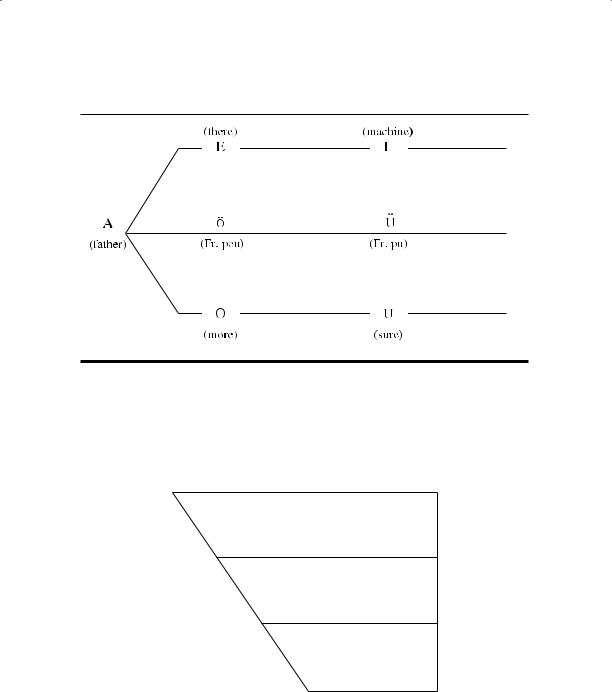
Phonetics
.pdf
|
|
|
Secondary Articulatory Gestures 235 |
||
|
|
|
|||
TABLE 9.4 |
Contrasts involving palatalization in Russian. |
|
|
||
|
|
|
|
|
|
formE |
‘form’ |
fΔErmE |
‘farm’ |
|
|
vItΔ |
‘to howl’ |
vΔitΔ |
‘to weave’ |
|
|
sok |
‘juice’ |
sΔok |
‘he lashed’ |
|
|
zof |
‘call’ |
zΔof |
‘yawn’ |
CD 9.9 |
|
pakt |
‘pact’ |
pΔatΔ |
‘five’ |
||
|
|||||
bˆl |
‘he was’ |
bΔil |
‘he stroked’ |
|
|
tot |
‘that’ |
tΔotΔE |
‘aunt’ |
|
|
domE |
‘at home’ |
dΔomE |
‘Dyoma’ [ nickname ] |
|
|
kuSEtΔ |
‘to eat’ |
kΔuvΔEtkE |
‘dish’ |
|
|
|
|
|
|
|
|
said to be palatalized because, instead of the velar contact of the kind that occurs in car [ kA® ], the place of articulation in key is changed so that it is nearer the palatal area. Similarly, palatalization is said to occur when the alveolar fricative [ z ] in is becomes a palato-alveolar fricative in is she [ IZSi ]. A further extension of the term palatalization occurs in discussions of historical sound change. In Old English, the word for chin was pronounced with a velar stop [ k ] at the beginning. The change of this sound into Modern English [ tS ] is said to be one of palatalization, due to the influence of the high front vowel. All these uses of the terms palatalization and palatalized involve descriptions of a process— something becoming something else—rather than a secondary gesture.
Velarization, the next secondary articulation to be considered, involves raising the back of the tongue. It can be considered as the addition of an [ u ]-like tongue position, but without the addition of the lip rounding that also occurs in [ u ]. We have already noted that in many forms of English, syllable final / l / sounds are velarized and may be written [ : ].
As an exercise, so that you can appreciate how it is possible to add vowel-like articulations to consonants, try saying each of the vowels [ i, e, E, a, A, O, o, u ], but with the tip of your tongue on the alveolar ridge. The first of these sounds is, of course, a palatalized sound very similar to [ lΔ ]. The last of the series is one form of velarized [ : ]. Make sure you can say each of these sounds before and after different vowels. Now compare palatalized and velarized versions of other sounds in syllables such as [ nΔa ] and [n◊a ]. Remember that [ n◊] with the velarization diacritic [◊] is simply [n] with a superimposed unrounded nonsyllabic [u] glide (that is, an added [ U ] glide).
Pharyngealization is the superimposition of a narrowing of the pharynx. Since cardinal vowel (5)—[A]—has been defined as the lowest, most back vowel possible without producing pharyngeal friction, pharyngealization may be considered as the superimposition of this vowel quality. One IPA diacritic for symbolizing pharyngealization is [ º], the same as for velarization. If it is necessary to distinguish between these two secondary articulations, then the IPA provides an alternative: using small raised symbols corresponding to velar and pharyngeal
Copyright 2010 Cengage Learning, Inc. All Rights Reserved. May not be copied, scanned, or duplicated, in whole or in part.

236 CHAPTER 9 Vowels and Vowel-like Articulations
fricatives, representing a velarized alveolar nasal as [ n◊ ] and a pharyngealized alveolar nasal as [ n≥ ]. Marking velarization and pharyngealization in this way is also preferable when the use of the [ ]ºdiacritic creates a symbol that is hard to decipher.
There is very little difference between velarized and pharyngealized sounds, and no language distinguishes between the two possibilities. In Arabic, there is a series of consonants that Arabic scholars call emphatic consonants. Some of these sounds are velarized, and some are pharyngealized. All of them can be symbolized with the IPA diacritic [ ]º. (Arabic scholars often use a subscript dot [ . ].) There is some similarity in quality between retroflex stops and velarized or pharyngealized stops, because in all these sounds, the front of the tongue is somewhat hollowed.
Labialization, the addition of lip rounding, differs from the other secondary articulations in that it can be combined with any of them. Obviously, palatalization, velarization, and pharyngealization involve different tongue shapes that cannot occur simultaneously. But nearly all kinds of consonants can have added lip rounding, including those that already have one of the other secondary articulations. In a sense, even sounds in which the primary articulators are the lips— for example, [ p, b, m ]—can be said to be labialized if they are made with added rounding and protrusion of the lips. Because labialization is often accompanied by raising the back of the tongue, it is symbolized by a raised [ W ]. In a more precise system, this might be taken to indicate a secondary articulation that we could call labiovelarization, but this is seldom distinguished from labialization.
In some languages (for instance, Twi and other Akan languages spoken in Ghana), labialization co-occurs with palatalization. As palatalization is equivalent to the superimposition of a gesture similar to that in [ i ], labialization plus palatalization is equivalent to the superimposition of a rounded [ i ]—that is, [ y ]. As we have seen, the corresponding semivowel is [ μ ]. Accordingly, these secondary articulations may be symbolized by a raised [ μ ]. Recall the pronunciation of [ μ ] in French words such as huit [ μit ] “eight.” Then try to pronounce the name of one of the dialects of Akan, Twi [ tμi ].
Table 9.5 summarizes the secondary gestures we have been discussing. As in some of the previous summary tables, the terms in Table 9.5 are not all mutually exclusive. A sound may or may not have a secondary articulation such
TABLE 9.5 Secondary gestures.
Phonetic Term |
Brief Description |
Symbols |
|
|
|
|
|
palatalization |
raising of the front of the tongue |
sΔ lΔ |
dΔ |
velarization |
raising of the back of the tongue |
s◊ : |
b◊ |
pharyngealization |
retracting of the root of the tongue |
s≥ : |
b≥ |
labialization |
rounding of the lips |
sW lW dW |
|
Copyright 2010 Cengage Learning, Inc. All Rights Reserved. May not be copied, scanned, or duplicated, in whole or in part.

Exercises 237
as palatalization, velarization, or pharyngealization; it may or may not be labialized; and it may or may not be nasalized. To demonstrate this for yourself, try to make a voiced alveolar lateral [ l ] that is also velarized, labialized, and nasalized.
EXERCISES
(Printable versions of all the exercises are available on the CD.)
A.Look at the positions of the tongue in the English vowels shown in Figure 1.12. It has been suggested (see “Notes”) that vowels can be described in terms of three measurements: (1) the area of the vocal tract at the point of maximum constriction; (2) the distance of this point from the glottis; and (3) a measure of the degree of lip opening.
1.Which of the first two corresponds to what is traditionally called vowel height for the vowels in heed, hid, head, had?
2.Which corresponds to vowel height for the vowels in father, good, food?
3.Can these two measurements be used to distinguish front vowels from back vowels?
B.Another way of describing the tongue position in vowels that has been suggested (see “Endnotes”) is to say that the tongue is in a neutral position in the vowel in head and that (1) the body of the tongue is higher than in its neutral position in vowels such as those in heed, hid, good, food; (2) the body of the tongue is more back than in its neutral position in good, food, father; (3) the root of the tongue is advanced in heed, food; and (4) the root of the tongue is pulled back so that the pharynx is more constricted than in the neutral position in had, father. How far do the data in Figure 1.12 support these suggestions?
C.In the seventeenth, eighteenth, and early nineteenth centuries (see “Endnotes” ), there were said to be three sets of vowels: (1) a set exemplified by the vowels in see, play, father (and intermediate possibilities), which were said to be distinguished simply by the degree of jaw opening; (2) a set exemplified by the vowels in fool, home, father (and intermediate possibilities), which were said to be distinguished simply by the degree of lip rounding; and (3) a set exemplified by the vowels now symbolized by [ y, „ ] as in the French words tu, peu ‘you, small,’ which were said to be distinguished by both the degree of jaw opening and the degree of lip rounding. These notions were shown in diagrams similar to that in Figure 9.14. How do they compare with contemporary descriptions of vowels? What general type of vowel cannot be described in these terms?
Copyright 2010 Cengage Learning, Inc. All Rights Reserved. May not be copied, scanned, or duplicated, in whole or in part.

238CHAPTER 9 Vowels and Vowel-like Articulations
Figure 9.14 The vowel classification used by Helmholtz (1863), with key words suggested by Ellis (1885).
D.Try to find a speaker of some language other than English. Elicit a set of minimal pairs exemplifying the vowels of this language. You will probably find it helpful to consult the pronunciation section in a dictionary or grammar of the language. Listen to the vowels and plot them on a vowel chart. (Do not attempt this exercise until you have worked through the Performance Exercises for this chapter.)
PERFORMANCE EXERCISES
The object of many of the following exercises is to get you to produce a wide variety of vowels that are not in your own language. When you can produce small differences in vowel quality, you will find it easier to hear them.
Copyright 2010 Cengage Learning, Inc. All Rights Reserved. May not be copied, scanned, or duplicated, in whole or in part.

Performance Exercises 239
A.Say the monophthongs [ i, e ] corresponding to at least the first part of your vowels in see, say. Try to make a vowel with a quality in between [ i ] and [ e ]. Then make as many vowels as you can in a series between [i] and [e]. Finally, make a similar series going in the opposite direction—from [e] to [i].
B.Repeat this exercise with monophthongs corresponding to the following pairs of vowels in your own speech. Remember to produce each series in both directions.
[ I–” ]
[ ”–œ ]
[ œ–A ]
[ A–O ], if occurring in your speech
[ O–o ] or [A–o ]
[o–u ]
C.Try moving continuously from one member of each pair to the other, slurring through all the possibilities you produced in the previous exercises. Do this in each direction.
D.For each pair of vowels, produce a vowel that is, as nearly as you can determine, halfway between the two members.
E.Repeat Exercises A, C, and D with the following pairs of vowels, which will involve producing larger adjustments in lip rounding. Remember to produce each series in both directions, and be sure you try all the different tasks suggested in Exercises A, C, and D.
[ i–u ]
[e–o ]
F.Now repeat all the same exercises, but with no adjustments in lip rounding, using the following pairs of vowels. Go in both directions, of course.
[ i–U ]
[ e–V ]
[ y–u ]
[„–o ]
G.Practice distinguishing different central vowels. When you have learned to produce a high-central unrounded vowel [ ˆ ], try to produce midand lowcentral unrounded vowels, which may be symbolized [ ´ ] and [ ∏ ]. Try Exercises A, C, and D with the following pairs of vowels:
[ ˆ–´ ]
[ ´–∏ ]
Copyright 2010 Cengage Learning, Inc. All Rights Reserved. May not be copied, scanned, or duplicated, in whole or in part.

240 CHAPTER 9 Vowels and Vowel-like Articulations
H.Produce the following nasal and oral vowels. When making the nasalized vowels, be careful to keep the same tongue position, moving only the soft palate.
)
[ i–i–i ]
[ e–e)–e ]
[ œ–œ)–{ ]
[ A–A)–A]
[ o–o)–o ]
[u–u)–u ]
I.Now compare nasalized vowels with oral vowels that have slightly different tongue positions. Say:
) )
[ i–i–I–i ]
[ e–e)–”–e)]
[ ”–”)–œ–”)]
[ u–u)–o–u)]
[o–o)–O–o)]
J.Make sure you can produce a variety of different vowels by saying nonsense words such as those shown below, preferably to a partner who can check your pronunciation.
·petuz sy·t„t ·m”)nod
·tynob di·gUd pœ·nyt
·bUg”d mo·pAt ·degu)n
·nis„p gu·dob sy·to)n
·bœdid kU·typ ·k„b”)s
K.Learn to produce diphthongs going to and from a variety of vowels. Using the vowel symbols with their values as in English, read the following, first column by column, then row by row.
iI |
Ii |
ei |
”i |
œi |
Ai |
Oi |
oi |
Ái |
ui |
Øi |
ie |
Ie |
eI |
”I |
œI |
AI |
OI |
oI |
ÁI |
uI |
ØI |
i” |
I” |
e” |
”e |
œe |
Ae |
Oe |
oe |
Áe |
ue |
Øe |
iœ |
Iœ |
eœ |
”œ |
œ” |
A” |
O” |
o” |
Á” |
u” |
Ø” |
iA |
IA |
eA |
”A |
œA |
Aœ |
Oœ |
oœ |
Áœ |
uœ |
؜ |
iO |
IO |
eO |
”O |
œO |
AO |
OA |
oA |
ÁA |
uA |
ØA |
io |
Io |
eo |
”o |
œo |
Ao |
Oo |
oO |
ÁO |
uO |
ØO |
iÁ |
IÁ |
eÁ |
”Á |
œÁ |
AÁ |
OÁ |
oÁ |
Áo |
uo |
Øo |
iu |
Iu |
eu |
”u |
œu |
Au |
Ou |
ou |
Áu |
uA! |
ØA! |
iØ |
IØ |
eØ |
ӯ |
ϯ |
AØ |
OØ |
oØ |
ÁØ |
uØ |
Øu |
Copyright 2010 Cengage Learning, Inc. All Rights Reserved. May not be copied, scanned, or duplicated, in whole or in part.

Performance Exercises 241
L.Try saying some of these diphthongs in one-, two-, and three-syllable nonsense words such as those shown below. These are good items to use in ear-training practice with a partner.
tIop |
·doeb·mOid |
sœo·tAoneu |
tØep |
·deub·mAud |
sOA·t”onIÁ |
tAOp |
·dIÁb·mØOd |
so”·tœunue |
t”Ap |
·doeb·moid |
sAØ·tØinui |
toØp |
·dÁ”b·nu”d |
sOI·tIunœA |
M.Now extend your range by including front rounded and back unrounded vowels as exemplified below.
iy |
ey |
Ay |
uy |
yi |
„i |
Ui |
y„ |
„y |
Uy |
i„ |
e„ |
A„ |
u„ |
ye |
„e |
Ue |
yU |
„U |
U„ |
iU |
eU |
AU |
uU |
yA |
„A |
UA |
yu |
„u |
Uu |
N.These vowels can also be included in nonsense words such as those shown below for both performance and ear-training practice.
dUeb |
·tyœb·meyd |
tUy·neAsØ„ |
di„b |
·tuÁb·mu„d |
tue·n„usÁI |
deub |
·tO„b·mAud |
t”U·noysœu |
doub |
·t„Áb·mU”d |
tyI·n„ysoO |
dœob |
·tUAb·miod |
tA„·nAesIy |
O.Practice all the vowels and consonants discussed in the previous chapters in more complicated nonsense words such as the following:
VA·rot1iF |
NOv„·d1e= |
jœLU·∫eÎ |
be·Ô”ZuD |
GACy·bIg |
sy·t'o∑”k˘ |
≠i·∂yx”n1 |
ße?O·pœz |
¥”·n„k'œx |
Tœ·–AkUS |
fi‰o·ce¬ |
k!i®u·god |
Ω„·XoqOl |
heBU·Ôœt |
wup'O·k˘˘em |
Copyright 2010 Cengage Learning, Inc. All Rights Reserved. May not be copied, scanned, or duplicated, in whole or in part.

Copyright 2010 Cengage Learning, Inc. All Rights Reserved. May not be copied, scanned, or duplicated, in whole or in part.

10
Syllables and
Suprasegmental Features
Throughout this book, there have been references to the notion syllable, but this term has never been defined. The reason for this is simple: there is no agreed phonetic definition of a syllable. This chapter will discuss some of the theories that have been advanced and show why they are not entirely adequate. We will also consider suprasegmental features—those aspects of speech that involve more than single consonants or vowels. The principal suprasegmental features are stress, length, tone, and intonation. These features are independent of the categories required for describing segmental features (vowels and consonants), which involve airstream mechanisms, states of the glottis, primary and secondary articulations, and formant frequencies.
SYLLABLES
The fact that syllables are important units is illustrated by the history of writing. Many writing systems have one approximately symbol for each syllable, a well-known present-day example being Japanese. But only once in the history of humankind has anybody devised an alphabetic writing system in which syllables were systematically split into their components. About three thousand years ago, the Greeks modified the Semitic syllabary so as to represent consonants and vowels by separate symbols. The later Aramaic, Hebrew, Arabic, Indic, and other alphabetic writing systems can all be traced back to the principles first and last established in Greek writing. It seems that everybody finds syllables comparatively easy units to identify. But people who have not been educated in an alphabetic writing system find it much more difficult to consider syllables as being made up of segments (consonants and vowels).
Most syllables contain both vowels and consonants, but some, such as eye and owe, have only vowels. Many consonants can also function as syllables. Alveolar laterals and nasals (as at the ends of button and bottle) are common in English, but other nasals may occur, as in blossom and bacon, particularly in phrases such as the blossom may fade and bacon goes well with eggs, in which the following sounds aid the assimilatory process. Fricatives and stops may
243
Copyright 2010 Cengage Learning, Inc. All Rights Reserved. May not be copied, scanned, or duplicated, in whole or in part.

244 CHAPTER 10 Syllables and Suprasegmental Features
become syllabic in unstressed syllables as in suppose and today, which may be [ s`·poÁz ] and [ t `Ó·deI ] in a narrow transcription. People vary in their pronunciation of these words and phrases. For us, they are all syllabic consonants, but others may consider all the examples in this paragraph as consisting of a consonant and an associated [ ´ ].
Although it is difficult to define what is meant by a syllable, nearly everybody can identify individual syllables. If you consider how many syllables there are in minimization or suprasegmental, you can easily count them. Each of these words has five syllables. Nevertheless, it is curiously difficult to state an objective phonetic procedure for locating the number of syllables and especially the boundaries between syllables in a word or a phrase in any language, and it is interesting that most people cannot say how many syllables there are in a phrase they have just heard without first saying that phrase themselves.
In a few cases, people disagree on how many syllables there are in a word in English. Some of these disagreements arise from dialectal differences in the way particular words are spoken. For some, the word predatory has three syllables because they say [ ·pr”dEtrI ]. Other people who pronounce it as [·pr”dEtO®i] say that it has four syllables. Similarly, there are many words, such as bottling and brightening, that some people pronounce with syllabic consonants in the middle, so that they have three syllables, whereas others do not.
There are also several groups of words that people pronounce the same way, but nevertheless differ in their estimates of the number of syllables. One group of words contains nasals that may or may not be counted as separate syllables. Thus, words such as pessimism and mysticism may be said to have three or four syllables, depending on whether the final [ m ] is considered to be syllabic. A second group contains high front vowels followed by / 1 /. Many people will say that meal, seal, reel contain two syllables, but others will consider them to have one. A third group contains words in which / r / may or may not be syllabic. Some people consider hire, fire, hour to be two syllables, whereas others (who pronounce them in exactly the same way) do not. Similar disagreements also arise over words such as mirror and error for some American English speakers. Finally, there is disagreement over the number of syllables in a group of words that contain unstressed high vowels followed by another vowel without an intervening consonant. Examples are words such as mediate, heavier, Neolithic. Differences of opinion as to the number of syllables in these words may be due to differences in the way they are actually pronounced, just as in the case of predatory cited earlier. But, unlike predatory, it is often not clear if a syllable has been omitted on a particular occasion.
It is also possible that different people do different things when asked to say how many syllables there are in a word. Some people may pay more attention to the phonological structure of words than others. Thus, many people will say that realistic has three syllables. But others will consider it to have four syllables
Copyright 2010 Cengage Learning, Inc. All Rights Reserved. May not be copied, scanned, or duplicated, in whole or in part.
